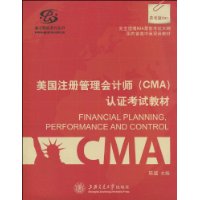-
>
2021年国家统一法律职业资格考试案例分析指导用书(全2册)
-
>
公务员考试:决战行测5000题:资料分析(全2册)
-
>
安全生产管理 2019版中级
-
>
马克思主义基本原理概论 自学考试学习读本 (2018年版)
-
>
中国近现代史纲要自学考试学习读本(2018年版)
-
>
呼兰河传
-
>
普通话水平测试专用教材
美国注册管理会计师(CMA)认证考试教材 版权信息
- ISBN:9787313061553
- 条形码:9787313061553 ; 978-7-313-06155-3
- 装帧:暂无
- 册数:暂无
- 重量:暂无
- 所属分类:>>
美国注册管理会计师(CMA)认证考试教材 本书特色
《美国注册管理会计师(CMA)认证考试教材》完全遵循IMA*新考试大纲国内首套中英双语教材。
美国注册管理会计师(CMA)认证考试教材 目录
美国注册管理会计师(CMA)认证考试教材 节选
《美国注册管理会计师(CMA)认证考试教材》内容简介:近年来,越来越多的中国财经、金融、管理专业人士开始关注和参加美国注册管理会计师考试。高才(中国)培训致力研发国内首套美国CMA考试双语教材,《美国注册管理会计师(CMA)认证考试教材》在内容上除了包括所有美国CMA考试大纲规定考试范围,更添加了许多中文背景注释、高才培训的提示和专业术语表,弥补了中国学员阅读纯英文CMA培训教材所遇到的语言和文化差异障碍。本系列丛书融合美国多所知名院校MBA课程内容设置,知识体系设置合理,内容翔实,理论联系实际,突出案例教学,深入浅出,易懂易学,并对所有概念的相关的考试掌握要求逐一做了图案标识并提示了记忆技巧。适合所有美国CMA考生阅读。
美国注册管理会计师(CMA)认证考试教材 相关资料
企划过程中最重要的部分之一就是必须确立企业对未来的设想。Since planning is looking into the future,the company must make some assumptions about the outlook for the environment in which its business operates.These assumptions are called premises.When identifying premises.it is essential that management focus only on those that will actually impact the potential success of their business. By focusing on premises that are not a critical part of the organization’s success,management is wasting valuable company time and resources.不同的部门必须决定其自身的前提,因为他们各自面对独特的任务。例如财务部门可能会对利息敏感,但对于生产部门来说,利息问题不会直接影响其完成部门目标。 Fulfilling objectives(完成目标)在企业制定出其目标和规划时,搭建能够帮助实现企业目标、政策、流程、规则的内部结构变得至关重要。政策、流程和规则是前馈控制(feed forward controls)的典例。A feed forward control是在主题发生之前 就已经有准备的控制。By giving people guidance about what problems may occur,it can often prevent these problems.And if a problem dose occur,people already know how to respond to the situation. Policies,procedures and rules are feed forward controls because they establish the way something is supposed to be done the first time.By having these detailed instructions,there is less chance that something will go wrong. PoliciesA policy is a general statement that guides the thinking,and therefore the actions,of employees and is involved in the decision-marking process.One of.the purposes of a policy is to provide the boundaries within which a person is supposed to and is able to make a decision.The policy is the preferred way of achieving the obj ectives of the company and should be used as a guide for that decision-maker.Because these are the guides to behavior within the company,a policy should:(1)Involve principles that are known by members of the organization.(2)Be consistent with other policies within the organization(和企业其他的政策保持一致
美国注册管理会计师(CMA)认证考试教材 作者简介
陈越,高才(中国)培训总裁兼首席培训师。
陈越先生目前是IMA协会唯一业裔董事,曾担任美国多家公司高级财务分析师,取得多项财会类CPA,CMA,CFM,CIA,AIA,LIFA权威证书,同时有着丰富的授课经验。
美国管理会计师协会董事会(Institute of Management Accountants)董事
同际金融协会(Institute of Research Associat ion)董事
美国注册会计师协会会员(American Institute of Certifled Accountants)
美国内部审计师协会会员(Institute of Internal Auditors)
英国国际会计师协会会员(Association of International Accountants)
2006年1月担任“哈佛上海论坛”财务部分
主讲
登入2003年世界名人录——“Who's Who”(财经类)并取得证书
登入2002年斯特莫北美名人录——“Who's Who”(财经类)并取得证书
- >
李白与唐代文化
李白与唐代文化
¥9.9¥29.8 - >
伯纳黛特,你要去哪(2021新版)
伯纳黛特,你要去哪(2021新版)
¥23.4¥49.8 - >
巴金-再思录
巴金-再思录
¥19.8¥46.0 - >
山海经
山海经
¥20.4¥68.0 - >
有舍有得是人生
有舍有得是人生
¥21.2¥45.0 - >
我与地坛
我与地坛
¥25.8¥28.0 - >
朝闻道
朝闻道
¥11.7¥23.8 - >
龙榆生:词曲概论/大家小书
龙榆生:词曲概论/大家小书
¥9.1¥24.0
-
2022图书×抽奖盲袋
¥9.9¥25 -
2023读书月阅读盲盒——天黑,闭眼,刀谁?
¥42.3¥158 -
2022读者节纪念徽章-三星会员专属
¥45¥45.6 -
2023读书月阅读盲盒——我什么场面没见过?
¥42.3¥158 -
2023读书月阅读盲盒——去码头整点什么薯条?
¥42.3¥158















